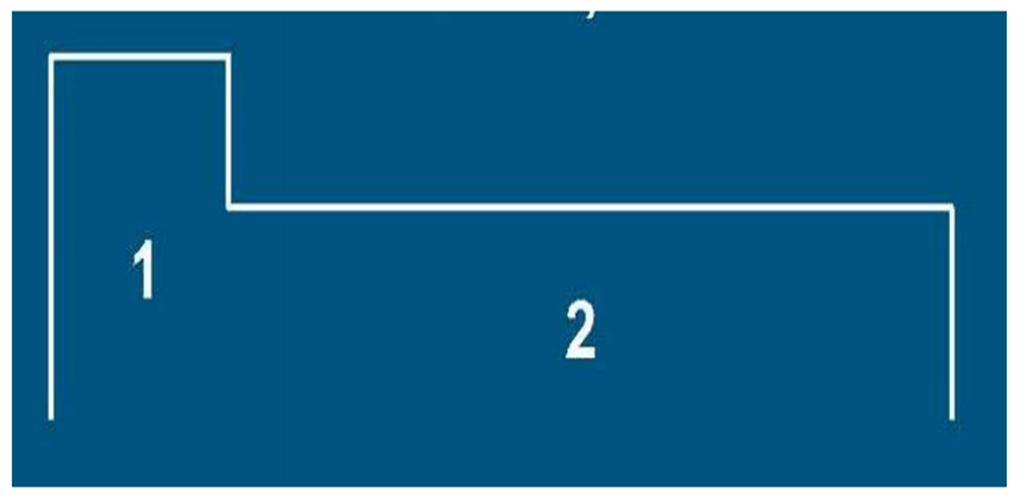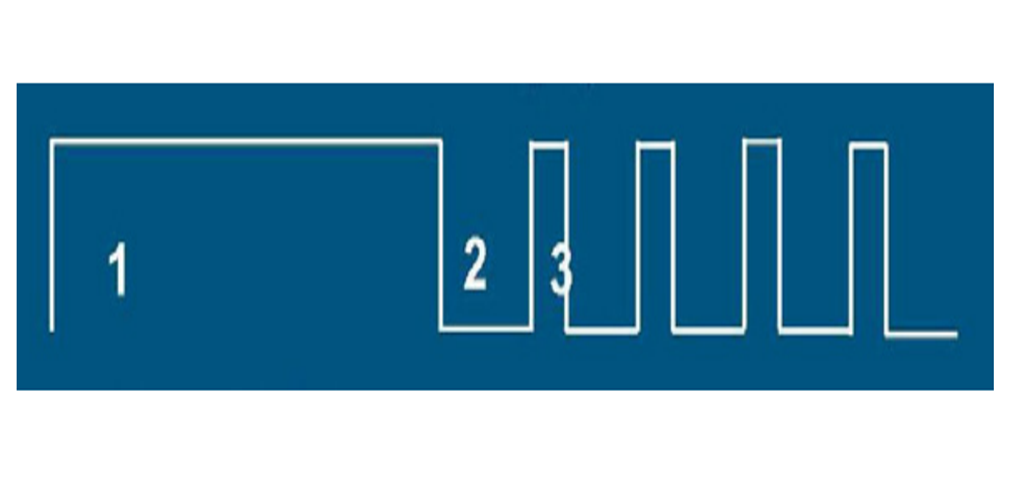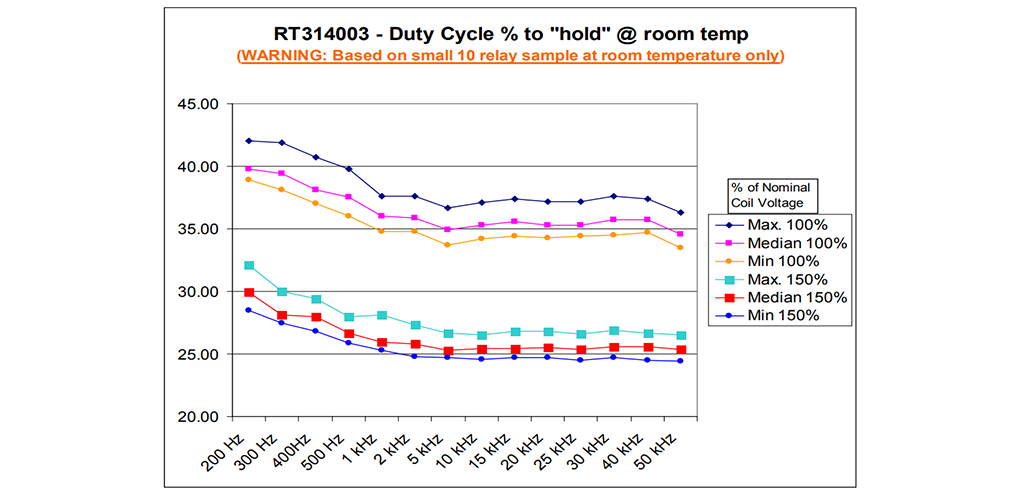Options for stepped down coil voltage and pulse width modulation (PWM)
Coil Power Reduction: (does not apply to latching relays)
It is often desirable to reduce total control power consumption and reduce heating. One way to do this is to reduce relay coil power consumption. Following are two methods used to accomplish that for DC coil relays. It is important to note, however, that reduction of coil power by any method reduces the relay’s ability to keep the relay armature seated, hence reducing the relay’s shock and vibration tolerance.
Similarly, if shock and/or vibration unlatch the relay, it will release and fail to re-operate until driven by at least the minimum operate voltage again. Especially in the case of safety-critical applications, care must be taken in the overall control design to accommodate this condition safely.
All such techniques rely on the “hold” voltage of the relay as defined in Application Note “Proper Coil Drive is Critical to Good Relay and Contactor Performance”. Note that the “hold” parameter is not normally controlled during manufacturing nor specified on the datasheet. If one plans to implement coil power reduction, one must consult TE Product Engineering at the least, and one may also be required to order a special relay whose “hold” voltage is controlled so that overall functionality is predictable and reliable.
- Stepped Down Coil Voltage:
One method to reduce coil power is to use two different, well filtered power supplies that are both connected to the relay coil (usually diode “OR’d” together for isolation) and to two separate drive means. There are also several different means of implementing this but the most common is shown following:

Figure 1.
First, (1) the relay is operated by enabling the higher of the two voltages (equal to or greater than the rated “nominal” coil voltage) for a minimum of 100 milli-seconds to operate and stabilize the relay reliably, then (2) the lower voltage with a magnitude at least equal to or greater than the “hold” voltage is enabled and the higher voltage drive is disabled so that the lower voltage holds the relay in the operated state.
Depending on how low the “hold” voltage for that relay is and the ambient temperature variation, the designer must ensure that the “hold” voltage is high enough to accommodate the shock and vibration level expected in the application and that the armature remains seated.
For some relay families that have already been studied, TE Product Engineering can offer some assistance in the details of this evaluation.
- PWM (Pulse Width Modulation)
Another method of reducing coil power is Pulse Width Modulation (PWM). In this scheme, the relay coil is driven by an initial DC voltage level (1) of at least the rated “operate” voltage for a minimum of 100 mill-seconds then the drive transistor is switched “off” (2) and “on” (3) at some desirable frequency and duty cycle that will “hold” the relay in its operated state. Since the frequency and duty cycle response varies for each relay mechanism, coil voltage, coil power and several other factors, this is a complex implementation. TE Product Engineering should always be consulted during the control design phase.

Figure 2.
General PWM Tips:
- A “recirculating diode” must always be used directly across the relay coil to allow the current to re-circulate and assist holding the relay in its operated state. No zener diode or resistor should be in the recirculation loop because that reduces the ability to withstand the “off” time.
- Especially above approximately 10 kHz, the switching transistor must be rated to be reliable at that frequency and the diode across the coil must be a Shottky or Fast Recovery type. This usually means that Darlington transistors are not usable above 10kHz and that FETs or high gain bi-polar transistors of some type are required.
- It is generally recommended that the frequency be no less than 15 kHz, to avoid audible control noise - especially for quiet environment applications.
Depending on the applied voltage, the frequency response of the relay type and the ambient temperature variation (which affects L/R ratio and thus frequency response), the designer must ensure that the voltage, frequency and duty-cycle are sufficient to accommodate the shock and vibration level expected in the application.
For some relay families that have already been studied, TE Product Engineering can offer some assistance in the details of this evaluation.
Below is a typical example of the frequency and duty cycle response of one particular relay giving the absolute minimum values needed to hold the relay in its operated state at different frequencies and duty cycles. CAUTION: Values in the sample chart below are for reference only and are based on a small, 10 relay sample. They should never be used directly in control design because relay operation will also be affected by shock, vibration and coil temperature so a higher duty cycle would always be needed depending upon the application. Again, TE Product Engineering can advise in more detail - especially for those relay families for which such data exists.
Other Pulsed Coil Variants:
Various other pulsed coil drive schemes such as “chargepump” are also sometimes used, but they mostly use exponential (rather than rectangular) charge / discharge wave-shapes which are very difficult to evaluate and control to ensure proper coil drive. Such techniques should be used only after very careful evaluation.

Figure 3.
Options for stepped down coil voltage and pulse width modulation (PWM)
Coil Power Reduction: (does not apply to latching relays)
It is often desirable to reduce total control power consumption and reduce heating. One way to do this is to reduce relay coil power consumption. Following are two methods used to accomplish that for DC coil relays. It is important to note, however, that reduction of coil power by any method reduces the relay’s ability to keep the relay armature seated, hence reducing the relay’s shock and vibration tolerance.
Similarly, if shock and/or vibration unlatch the relay, it will release and fail to re-operate until driven by at least the minimum operate voltage again. Especially in the case of safety-critical applications, care must be taken in the overall control design to accommodate this condition safely.
All such techniques rely on the “hold” voltage of the relay as defined in Application Note “Proper Coil Drive is Critical to Good Relay and Contactor Performance”. Note that the “hold” parameter is not normally controlled during manufacturing nor specified on the datasheet. If one plans to implement coil power reduction, one must consult TE Product Engineering at the least, and one may also be required to order a special relay whose “hold” voltage is controlled so that overall functionality is predictable and reliable.
- Stepped Down Coil Voltage:
One method to reduce coil power is to use two different, well filtered power supplies that are both connected to the relay coil (usually diode “OR’d” together for isolation) and to two separate drive means. There are also several different means of implementing this but the most common is shown following:

Figure 1.
First, (1) the relay is operated by enabling the higher of the two voltages (equal to or greater than the rated “nominal” coil voltage) for a minimum of 100 milli-seconds to operate and stabilize the relay reliably, then (2) the lower voltage with a magnitude at least equal to or greater than the “hold” voltage is enabled and the higher voltage drive is disabled so that the lower voltage holds the relay in the operated state.
Depending on how low the “hold” voltage for that relay is and the ambient temperature variation, the designer must ensure that the “hold” voltage is high enough to accommodate the shock and vibration level expected in the application and that the armature remains seated.
For some relay families that have already been studied, TE Product Engineering can offer some assistance in the details of this evaluation.
- PWM (Pulse Width Modulation)
Another method of reducing coil power is Pulse Width Modulation (PWM). In this scheme, the relay coil is driven by an initial DC voltage level (1) of at least the rated “operate” voltage for a minimum of 100 mill-seconds then the drive transistor is switched “off” (2) and “on” (3) at some desirable frequency and duty cycle that will “hold” the relay in its operated state. Since the frequency and duty cycle response varies for each relay mechanism, coil voltage, coil power and several other factors, this is a complex implementation. TE Product Engineering should always be consulted during the control design phase.

Figure 2.
General PWM Tips:
- A “recirculating diode” must always be used directly across the relay coil to allow the current to re-circulate and assist holding the relay in its operated state. No zener diode or resistor should be in the recirculation loop because that reduces the ability to withstand the “off” time.
- Especially above approximately 10 kHz, the switching transistor must be rated to be reliable at that frequency and the diode across the coil must be a Shottky or Fast Recovery type. This usually means that Darlington transistors are not usable above 10kHz and that FETs or high gain bi-polar transistors of some type are required.
- It is generally recommended that the frequency be no less than 15 kHz, to avoid audible control noise - especially for quiet environment applications.
Depending on the applied voltage, the frequency response of the relay type and the ambient temperature variation (which affects L/R ratio and thus frequency response), the designer must ensure that the voltage, frequency and duty-cycle are sufficient to accommodate the shock and vibration level expected in the application.
For some relay families that have already been studied, TE Product Engineering can offer some assistance in the details of this evaluation.
Below is a typical example of the frequency and duty cycle response of one particular relay giving the absolute minimum values needed to hold the relay in its operated state at different frequencies and duty cycles. CAUTION: Values in the sample chart below are for reference only and are based on a small, 10 relay sample. They should never be used directly in control design because relay operation will also be affected by shock, vibration and coil temperature so a higher duty cycle would always be needed depending upon the application. Again, TE Product Engineering can advise in more detail - especially for those relay families for which such data exists.
Other Pulsed Coil Variants:
Various other pulsed coil drive schemes such as “chargepump” are also sometimes used, but they mostly use exponential (rather than rectangular) charge / discharge wave-shapes which are very difficult to evaluate and control to ensure proper coil drive. Such techniques should be used only after very careful evaluation.

Figure 3.
